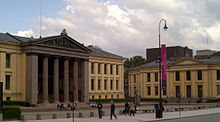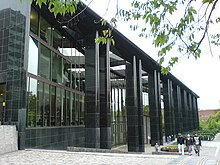University of Oslo
| University of Oslo (1811–1939: Royal Frederick University) |
|
|---|---|

|
|
| founding | September 2, 1811 |
| Sponsorship | state |
| place | Oslo , Norway |
| Rector | Svein Stølen (2017-2021) |
| Students | approx. 30,500 (as of 2019) |
| Employee | approx. 7,000 (as of 2019) |
| Annual budget | 8.15 billion NOK (as of 2019) |
| Networks | IAU |
| Website | www.uio.no |


The University of Oslo ( Norwegian Universitetet i Oslo , Latin Universitas Osloensis ) is the oldest and second largest university in Norway with 30,505 students and 6,595 employees (as of 2019) .
It was founded in 1811 as the Royal Friedrichs University ( Universitas Regia Fredericiana , Norwegian / Danish Kgl. Frederiks Universitet ) based on the model of the Humboldt University . It was renamed to its current name in 1939.
history
King Friedrich VI. von Denmark campaigned for a long time against the idea of a university in Norway, which belongs to Denmark, because he feared it would support separatist feelings. However, he was convinced in a campaign in 1811, and Norway received its first university: the Royal Friedrichs University. The university was then founded in Christiania in 1813 and started with seven professors and 18 students. A year later Norway declared itself independent from Denmark.
In 1882 Cecilie Thoresen began studying at the Royal Friedrichs University as the first female student. The first female professor was Kristine Bonnevie in 1912. She received her professorship a year before women got the right to vote in Norway.
The Royal Friedrichs University was renamed University of Oslo ( Norwegian Universitetet i Oslo ) in 1939 .
In 1999 the new building for the university library was opened (Georg Sverdrups hus). It replaces the old building that was built in 1913.
On September 2, 2011, the University of Oslo celebrated its 200th birthday.
organization
The university is divided into eight faculties, which in turn are divided into departments. In addition, three museums (the Kulturhistorisk Museum , the Naturhistorisk Museum and the Museum für Universitätsgeschichte) and the Barony Rosendal , which is also a museum today, are attached to the university. The library and a number of interdisciplinary centers are also part of the University of Oslo's facilities. The academic institutions at the university are (as of July 2015):
-
Faculty of Law or Law:
- Department of Criminology and Sociology of Law
- Department of Private Law
- Department of Public Law and International Law / International Law
- Scandinavian Institute for the Law of the Sea
- Center for European Law
- Norwegian Center for Human Rights
-
Medical school
- Institute for Health and Society
- Institute for "Basic Medical Sciences"
- Institute for Clinical Medicine
- Biotechnological Center Oslo (BiO)
- Norwegian Center for Molecular Medicine (NCMM)
- Norwegian Center for the Study of Mental Diseases (NORMENT)
- Center for Immune System (CIR)
- Center for Cancer Biomedicine (CCB)
-
Faculty of Humanities (until 2005: Faculty of History and Philosophy)
- Department of Archeology, Conservation and History
- Department for Cultural Studies and Languages ( Romance Philology , Slavic Studies , English Studies , American Studies etc.)
- Department of Philosophy , Antiquity , Art History
- Department for Literature , Cultural Area Research and European Languages
- Department for Linguistics and Scandinavian Studies
- Department for Media and Communication
- Department of Musicology
- Center for Ibsen Studies
- Center for "Study of Mind in Nature"
- Center for "Multilingualism in Society across the Lifespan"
- Norwegian Institute in Rome
- Norwegian University Center in St. Petersburg
-
Mathematical - Natural Science Faculty
- Department of Life Sciences
- Faculty Department of Pharmacy
- Institute for Theoretical Astrophysics
- Department of Physics
- Department of Computer Science
- Department of Earth Sciences
- Department of Chemistry
- Department of Mathematics
- Center for Applied Mathematics
- Center for Earth Development
- Center for Ecological and Evolutionary Synthesis
- Center for Materials Research and Nanotechnology
- Center for Entrepreneurship
- Norwegian Center for Teaching
- Center for Theoretical Chemistry and Computational Chemistry (CTCC)
- Faculty of Social Sciences
- Department of Sociology and Anthropogeography
- Department of Political Science
- Department of Psychology
- Department of Social Anthropology
- Department of Economics
- Center for European Studies (Arena)
- Center for Gender Studies and Equality Research (ESOP)
- Center for Technology, Innovation and Culture (TIK-center)
-
Pedagogical (or educational science) faculty
- Department of Teacher Education and School Research
- Department of Special Education
- Department of Education
- Center for School Performance Assessment (CEMO)
- Center for teaching-learning research in teacher training (ProTed)
Nobel Prize Winner
The university has so far produced or employed six Nobel Prize winners:
- Fridtjof Nansen (1861–1930), Peace Prize (1922)
- Ragnar Anton Kittil Frisch (1895–1973), Economy (1969)
- Odd Hassel (1897–1981), Chemistry (1969)
- Willy Brandt (1913–1992), Peace Prize (1971)
- Ivar Giaever (* 1929), Physics (1973)
- Trygve Haavelmo (1911–1999), Economy (1989)
seal
The seal of the University of Oslo shows Apollo with the lyre , and dates from 1835. The seal has been revised several times over the years, most recently in 2009.
See also
- List of modern universities in Europe (1801–1945)
- List of Rectors of the University of Oslo
- Den norske Studentersangforening
- Det norske Studentersamfund
Web links
- Official website of the university (Norwegian or English)
Individual evidence
- ^ List of IAU Members. In: iau-aiu.net. International Association of Universities, accessed August 9, 2019 .
- ↑ UiO in figures 2019 ( English , Internet) Universitetet i Oslo. 2019 . Retrieved June 10, 2020.
- ↑ The largest study locations in Norway ( English , Internet) Central Statistical Office Norway . 2018 . Retrieved June 12, 2020.
- ^ Organization of the University of Oslo. UiO , 2013, accessed September 26, 2013 .
Coordinates: 59 ° 56 '23.7 " N , 10 ° 43' 19.4" E

